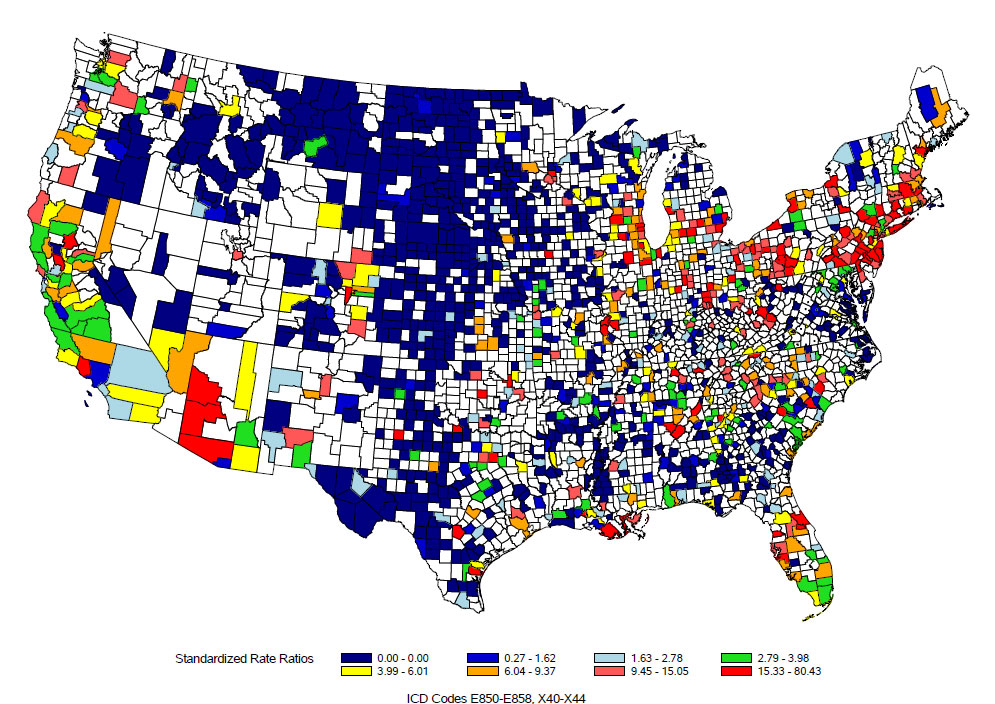Drug Overdose Deaths Increased 70-Fold in These US Counties

Some U.S. counties have seen a 70-fold increase in drug overdose deaths in the last few decades, a new study finds.
However, the areas with the highest increases in drug overdose deaths are not always the places with the most drug trafficking, as identified by the government, the study found. This suggests that drugs are passing through some high-trafficking counties without affecting death rates of the people in those regions, but are causing problems in other parts of the country, the researchers said.
"Our research reveals several potential new drug overdose problem regions that warrant careful attention as they may not correspond to areas covered by federal resources to combat drug trafficking," study co-author Jeanine Buchanich, deputy director of the University of Pittsburgh's Center for Occupational Biostatistics and Epidemiology, said in a statement.
For example, western Pennsylvania has one of the fastest-growing rates of drug overdose in the nation, but it is not an area with a lot of drug trafficking, Buchanich said. [Top 10 Leading Causes of Death]
In the study, researchers analyzed information on U.S. accidental drug-overdose deaths from 1979 to 2014. During this time period, the death rates from drug overdose increased 6.7 percent each year, on average, from 2,475 total deaths in the U.S. in 1979 to 38,675 total deaths in 2014.
The counties with the largest increases in drug overdose death rates were clustered in southern Michigan, eastern Ohio, western and eastern Pennsylvania, as well as in New Jersey, much of southeastern New York and coastal New England, the researchers said.
In particular, the counties of Jefferson, Louisiana; Norfolk, Massachusetts; Franklin, Ohio; Montgomery, Ohio; Summit, Ohio; and Kanawha, West Virginia, saw 70-fold increases in drug overdose death rates during the study period.
Sign up for the Live Science daily newsletter now
Get the world’s most fascinating discoveries delivered straight to your inbox.
In contrast, counties in the Midwest, California and Texas saw little to no change in drug overdose deaths during this period, the study found.
The researchers also analyzed drug overdose deaths in the 31 counties that are part of the U.S. High Intensity Drug Trafficking Areas program. These areas receive federal resources to reduce drug trafficking and production.
Some of the counties with high drug trafficking also had large increases in drug overdose deaths, including areas in Ohio and West Virginia. But some counties, like Norfolk, Massachusetts, are not considered high-trafficking areas, and yet had large increases in drug overdose deaths. In addition, high-trafficking areas near the borders in California, Texas and southern Florida had drug overdose death rates that were lower than the national average in 2014.
"The drug poisoning mortality epidemic is continuing to grow," the researchers said. "While resources are justifiably being targeted to the high-intensity drug-trafficking areas, they must also be allocated to counties outside those areas with rapidly increasing and currently high drug overdose rates," Buchanich said.
The study was published April 13 in the journal Preventive Medicine.
Follow Rachael Rettner @RachaelRettner. FollowLive Science @livescience, Facebook& Google+. Original article on Live Science.

Rachael is a Live Science contributor, and was a former channel editor and senior writer for Live Science between 2010 and 2022. She has a master's degree in journalism from New York University's Science, Health and Environmental Reporting Program. She also holds a B.S. in molecular biology and an M.S. in biology from the University of California, San Diego. Her work has appeared in Scienceline, The Washington Post and Scientific American.









